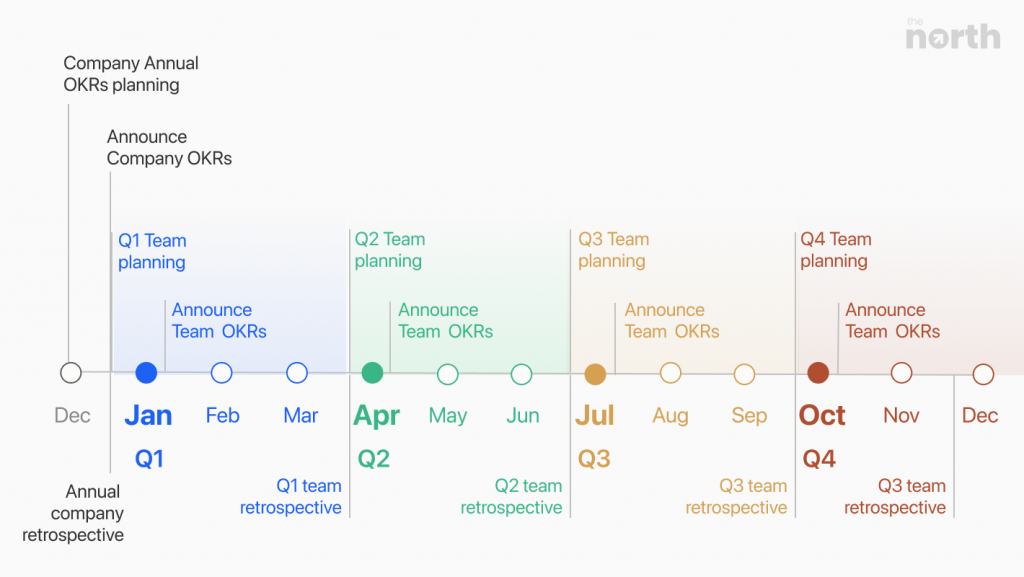North is a company-wide goal-setting system designed for organisations to improve focus and be number-driven in achieving goals. North is based on a proven and established OKR framework used by companies like Google, LinkedIn, and Airbnb. If you’re just getting started with OKRs.
☞ See What are OKRs?
☞ See if OKRs are for you
☞ See an overview of how North works
☞ See hand-picked OKR Resources from across the internet
Step 1: Start small – choose a data-driven team
OKRs depend on measuring key metrics. So they are easily adaptable by any team or department that already uses KPI or any other form of Dashboard to track progress. Usually, these are Product teams, Sales teams, or Digital Marketing teams.
☞ Choose a metric from the AARRR framework
☞ See how Product teams set OKRs
Step 2: Start at the beginning of a quarter or year
Here is a typical OKR timeline, you can pick a starting point that best suits you.

☞ See what a typical OKR planning cycle looks like
Step 3: Get buy-in from leadership
North and OKRs only work when the whole team commits to the OKR framework. without commitment, OKRs fail. the frameworks require a lot of trial and error so patience is key.
Step 4: Run an OKR workshop
Educate everyone involved with the basics of OKRs, see our learning resources page or better still hire an OKR Coach or appoint an Internal OKR Champion who is an OKR evangelist and can help teams throughout the process
☞ See curated OKR learning resources
Step 5: Nominate an OKR Champion
The above step will give you a good idea about who from your team is the most passionate and skilled at OKRs, Nominate them as your OKR champions. OKR Champions help with the following:
- Help create a detailed implementation plan
- Coach teams in OKRs as they go through the implementation phase
- Get feedback from people on how OKRs are working for them and what needs to change
- Make sure teams update OKRs regularly
Step 6: Create Organisation Goals (Optional)
Company goals and OKRs set the tone for teams to prioritise work. this is an important role of the senior leadership team. Start with your company mission, and strategy and write down your most important goals and outcomes that are relevant for your trial team to look up to.
☞ Choose a metric from the AARRR framework
☞ See how OKRs fit in your company strategy stack.
Create draft OKRs in a document or sheet first, then copy them into North before your OKR Kickoff.
Note: You may skip creating company goals as long as the said team or department you’re piloting OKRs with, know the key metrics important for them.
☞ See how Google CEO Sundar Pichai made Chrome the #1 browser with OKRs
Step 7: Create Team Goals
The team’s senior leaders will create their own OKRs to contribute to the organisation’s goals.
Step 8: Have an OKR Kickoff meeting
Announce OKRs within your entire company. Even though this is a pilot, announcing it to everyone helps teams get visibility into the process. it also creates a culture of transparency within the company where everyone knows everyone’s goals.
Step 9: Schedule your weekly check-in
This is a really important ritual to keep teams committed to the OKR process. if you don’t track OKRs they are easily forgotten. North automatically sends check-in reminders based on the frequency selected at the time of goal creation. but it helps to have this meeting on everyone’s calendar too.
☞ See how to run a weekly OKR check-in
Step 10: Learn the basics of OKRs in North
1. Goals Or Objectives
Goals in North are simple statements that tell people what the organisation or team aspires to achieve. It is the ultimate outcome of the work the team is going to undertake. There are two levels at which goals can be set. one is at the organisation level and another at a team or group level. more on that later…
2. Key Results
Key results talk about how you will measure your progress toward achieving the goals you set out. This is the most important ingredient that makes goal setting a lot more number-driven, and if you’re like us, a lot of fun too!
3. Initiatives
Initiatives are the actual work you and your team will undertake to achieve your goals and move your key results. An important note: Initiatives in North are not your everyday tasks – they do not replace your project management or task management tools like Trello or Asana or Jira. Initiatives are more like projects you list down and prioritise, they are more like Epics in Agile terms or Projects in more traditional terms
Step 11: Finally, avoid common OKR mistakes
Most companies that start to adopt OKRs, fail. We’ve spoken to experts to learn about the top reasons companies fail to use OKRs.
☞ Here are the 10 most common reasons why OKRs Fail
North is a single app for Strategy, OKRs, and Initiatives
North is built for data-driven companies that want to make an impact.
Companies of all sizes use North for strategy, goals and Initiatives.

Before you start
What are OKRs?
OKR Meaning
History of OKRs
Benefits of OKRs
Are OKRs right for me?
OKR Mistakes to Avoid
A Brief Guide to OKRs
Aligning with OKRs
Strategic Planning
OKRs in Strategy
SMART, MBO, BHAG
Role of an OKR Champion
Take the OKR Quiz
The North Guide to OKRs
Getting started with OKRs
How North works
A typical OKR Cycle
Planning your OKRs
Weekly OKR Check-In
Stretch vs Committed OKRs
Aligning vs Cascading OKRs
Aligning OKR Teams
OKRs vs KPI
OKR vs KPI: with Examples
Input vs Output metrics
Good and Bad OKRs
OKRs and Agile
OKR Templates
Learning resources
Vision & Mission Templates
Google OKR Template
OKRs for Product teams
OKRs for CEOs’ teams
OKRs for Sales teams
OKRs for Marketing teams
OKRs with Google Workspace
North Features
Getting started with North
Org and Team goals
Goal Initiatives
Goal Check-ins
Give Awards
Goal Alignment
Our take on Product
OKRs for AARRR Metrics
On Product discovery
Communicating well
Metrics for Product teams
Telling stories with data
Data visualisation
🏔
